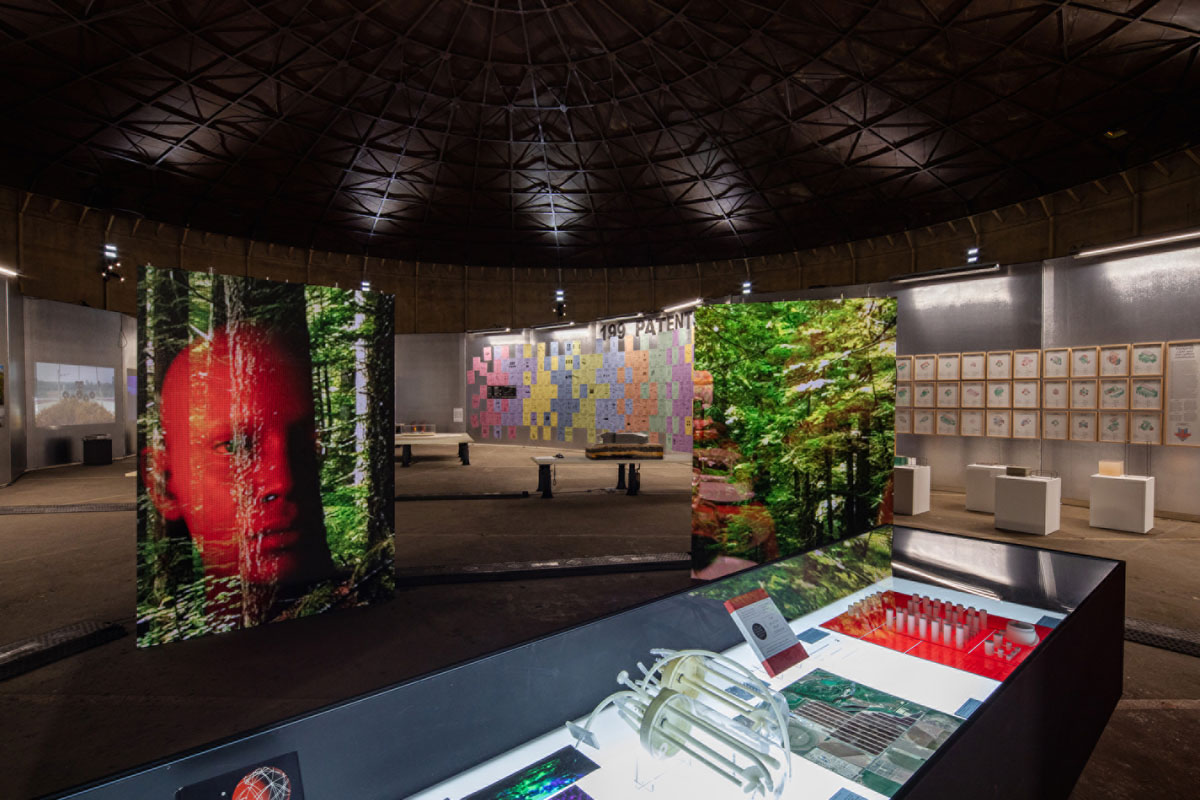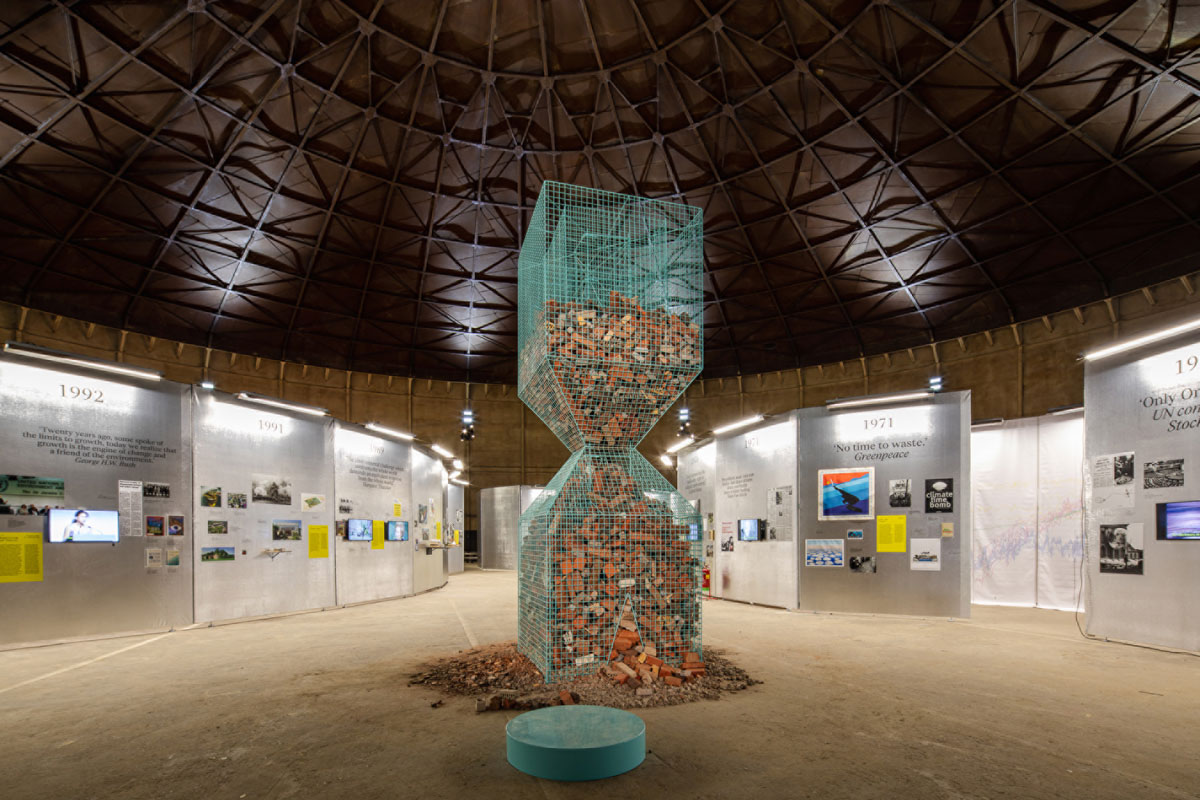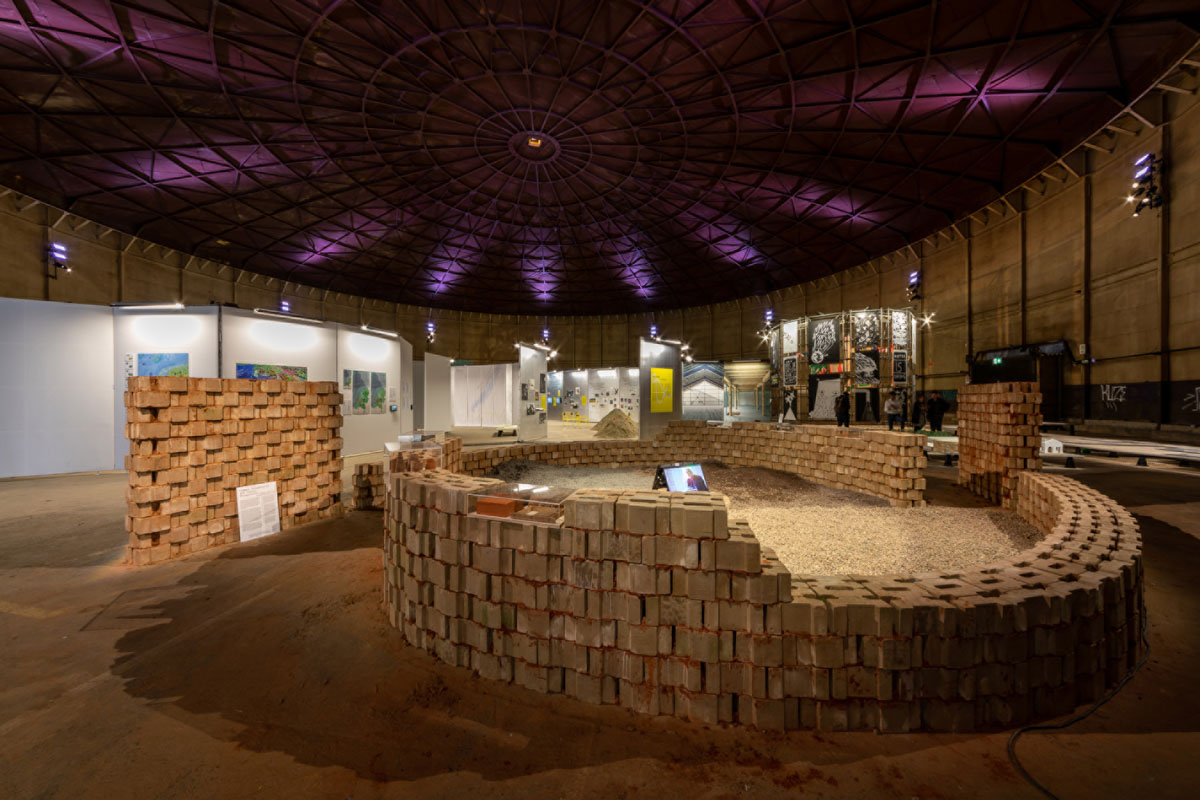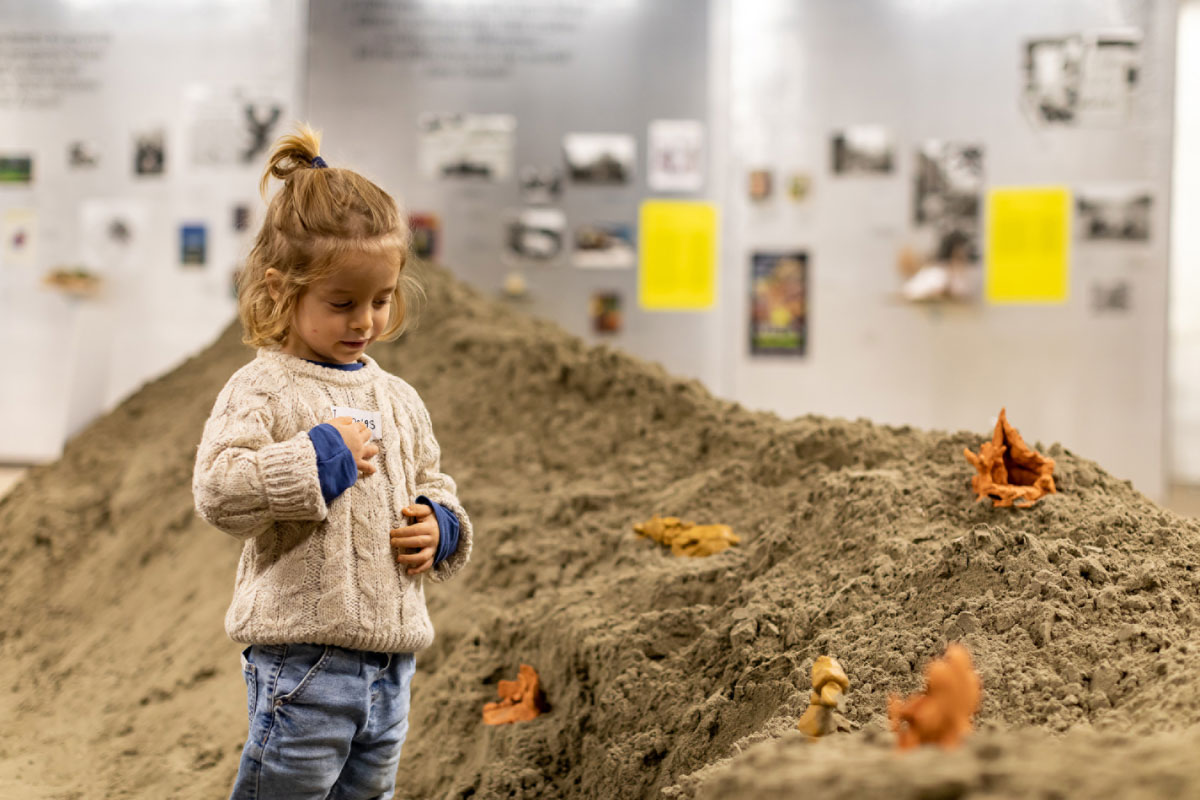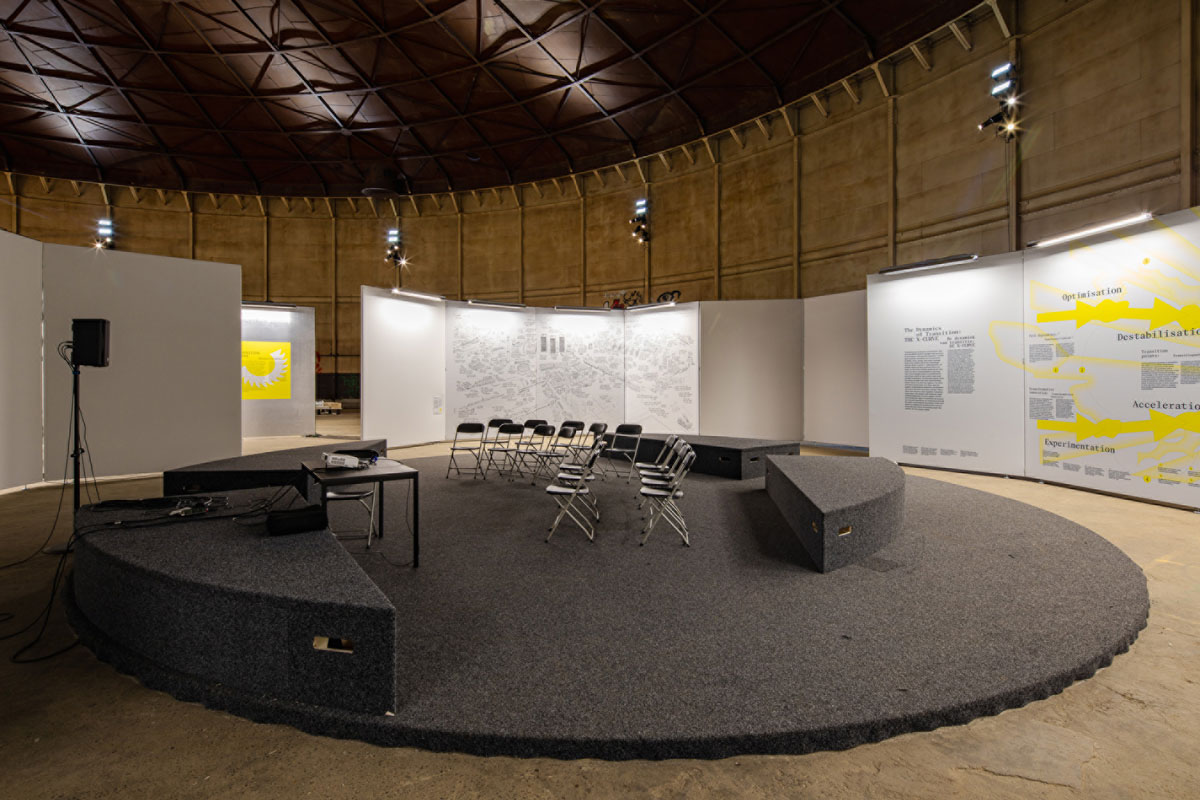As neo-Malthusian visions of humanitarian and ecological catastrophe become more palpable by the day, architects and representatives of allied fields recently answered the call of the International Architecture Biennale Rotterdam (IABR) to transform the post-apocalyptic interior of Rotterdam’s Ferro Dome into an exhibition that would serve as a design catalyst conceiving sustainable futures for the planet and its dwellers. The result was It’s About Time: The Architecture of Change (IAT), which ran for two months in the fall of 2022 (Figure 1).
Yet what can an exhibition actually do to effect systemic change on a global scale? How might an architecture biennale in one of Europe’s most competitive economies offer appropriate answers for the marginalized, precarious communities on whose exploitation much of its capital is built? Set in a former natural gas storage facility from the 1920s, the irony seems evident to anyone prematurely dismissing the projects assembled here as yet another disciplinary showcase of futile visions oscillating between utopian and dystopian realities à la OMA/AMO’s Countryside, The Future. Thematic novelty, however, may not be a functional qualifier for curatorial formats that address burning contemporary issues of resource depletion, forced displacement, and ecological collapse. The critical approaches to environmental sustainability below human comfort — mitigated by the curators as ‘livable futures’ — of the exhibition’s approximately 50 contributors avoid this risk, thanks to the synthetic curatorial effort of an international team comprising architectural historians and theorists Véronique Patteeuw and Léa-Catherine Szacka, societal transitions researcher Derk Loorbach, and landscape architect Peter Veenstra. Leveraging the venue’s carbon industrial specter at a time when news cycles were saturated with discussions of European overreliance on fossil fuels supplied by the warmongering Russian Federation, the IABR found a fitting setting for its tenth main showcase. On the circular, ironclad stage of the Ferro, as it is known, in Rotterdam’s Merwehaven area, historical inquiry and projected futures were productively juxtaposed and made to enfold alongside activist practices (from inside and outside the discipline), forcefully embodying the IABR’s main objective pursued since its founding in 2001: to ‘generate real world change’ (IABR 2022a). Visitors venturing to the nearby Keilezaal for the biennale’s captivating auxiliary exhibition Future Generation (curated by landscape architect Hanna Prinssen and architect Lindsey van de Wetering with junior curator Maria Christopoulou) encountered even more built futures in exceptionally lucid graduation projects by students from the Netherlands and Belgium.
IAT entwined a candid curatorial statement with a call to action. It took as its historical point of departure the 50th anniversary of the Club of Rome’s landmark report The Limits to Growth. First published in 1972 as a cautionary account of Earth’s interconnected ecological and industrial systems, the study predicted unchecked exponential growth trends in population, industrialization, natural-resource depletion, and pollution to overwhelm global ecosystems within the next 100 years (Meadows et al. 1972). Now, at the midpoint of this planetary deadline, the report’s strikingly accurate computer modeling, based on systems scientist Jay Forrester’s pioneering work at MIT, intensified feelings of uneasiness and reinvigorated technocratic debates that unite international scientists and politicians in conceiving ‘new critical frameworks for living and thriving within the limits on Planet Earth’ (The Club of Rome 2022). As Forrester observed earlier in World Dynamics, first published in 1971, limitations are not solely material problems; they also describe the ingrained sociocultural thresholds of human comfort. Effective change, he argued, may only be realized, ‘if we have a good understanding of the system dynamics and are willing to endure the self-discipline and pressures that must accompany the desirable mode’ (Forrester 1973: 112). Perhaps this fundamental necessity to renegotiate comfort on a sweeping societal and architectural scale, as Daniel A. Barber (2019) has convincingly argued, likewise echoed throughout the biennale’s structuring concept of design attitudes: the Ancestor, the Activist, and the Accelerator. While addressed directly only in one contribution to the exhibition — Atelier Julien Boidot’s design for a school with passive climate system — comfort and discomfort seem implicitly negotiated across temporal (Ancestor), societal (Activist), and technoscientific (Accelerator) scopes.
A variety of museographic devices manifested extended representations (e.g., freestanding display showing the IAT timeline, the exhibition’s larger historical context (Figure 2); the building-spanning mechanical clock installation Pendulum by Atelier Van Lieshout) and technological approaches (e.g., the MVRDV’s SolarScape VR-model of Rotterdam) to time and its spatial translations through various geographical and historical lenses (Figure 3). The curatorial coherence broadly achieved between the tripartite contributions ranging from hyperlocal to global narratives, however, missed an opportunity to unleash constructive frictions that smolder between the divergent approaches to worldmaking: ‘Ancestors are building for the long term’, ‘Activists are building for the change that starts today’, and ‘Accelerators are building a new world’ (IABR 2022b). Take, for example, the world governed by the more-than-human ‘Audement’, a nature-inclusive democracy ascribing political agency to water, sand, fish, seagulls, and so on, envisioned by the Dutch Studio Ossidiana and the Embassy of the North Sea. The governing ideals of this compassionate egalitarianism would certainly crack under the cold technoscientific speculations produced by the Milanese agency 2050+, whose striking multimedia installation Synthetic Cultures analyzed the spatial, ecological, and ethical impact of in vitro meat production for human consumption on the global landscape (Figure 1). On the other spectrum, pitting these future speculations against contemporary activist practice, the international movement Extinction Rebellion (XR) pressures governments and businesses to implement green policies via nonviolent actions of civil disobedience. Their exhibited XRchive collected the materials and methodologies of decentralized activism as a concrete toolset to enforce radical change.
A longing for potent dissonances to unfold certainly speaks more to the curatorial prowess than to the format’s ingrained limitations. IAT crammed an extended program of guided tours, lectures, debates, and workshops for children (Figure 4), adolescents, and adults within its seven weeks (Figure 5). Thus, for (one-time) visitors, access to the spectrum of knowledge and ideas collected in Rotterdam will remain suspended, awaiting the release of a forthcoming publication. Despite this fragmentary glimpse granted to most, rarely have recent international expositions understood the difference between showcase and exhibition as well as IAT has; its emphasis on engagement and dialog performed change rather than flaunted its dormant artifacts (i.e., the string of historical precedents that serve as an inert indexical backbone of global biennales, triennales, or documentas). This process-oriented approach materialized especially in the many exhibited projects developed for and with Dutch governmental clients as well as in the biennale’s transition arena, in which urban and landscape designers shared research into the ongoing transformation of the Netherlands.
The biennale’s plurality of worlds, while remaining unavailingly smooth at times, seeded hope that at least one of the potential solutions may succeed in forcing transformative change. However, interspersed reflections on historical crises (e.g., the 1973 oil crisis) and failed architectural interventions (e.g., OM Ungers’ Solar House of 1980), whose green techno-utopian desires were often crushed by neoliberal short-termism or politicized climate denialism, sobered up anyone prematurely content. Ranging from object-oriented environs to ecologies of the inhuman, from multispecies justice to convivial degrowth, IAT nimbly unthreaded the thinning border that separates hope and disillusionment. Oscillating cunningly between notions of earliness and lateness (i.e., propositions either too advanced for their time to be adopted or too late to effect necessary ecological modernization), the curators of IAT staked the critical timing of thinking too late for the perfect reply. And although the biennale may not hold all the answers to humanity’s current predicament, by building a cross-fertilizing network of polyphonous histories and practices of architecture, IAT fed environmental implementations on local and regional scales that retrain sociocultural thresholds of comfort and excitingly drive change, step by step.
Competing Interests
The author has no competing interests to declare.
References
Barber, DA. 2019. After Comfort. Log, 47: 45–50. DOI: http://doi.org/10.1353/hms.2019.0019
Forrester, JW. 1973. World Dynamics. 2nd ed. Cambridge, MA: Wright-Allen Press.
IABR (International Architecture Biennale Rotterdam). 2022a. Mission Statement. Available at https://www.iabr.nl/en/over/mission_statement [last accessed December 10, 2022].
IABR (International Architecture Biennale Rotterdam). 2022b. It’s About Time: The Architecture of Change, Exhibition (wall) texts: ‘Ancestor’, ‘Activist’, ‘Accelerator’.
Meadows, DH, Meadows, DL, Randers, J and Behrens III, WW. 1972. The Limits to Growth: A Report for the Club of Rome’s Project on the Predicament of Mankind. New York: Universe Books. DOI: http://doi.org/10.1349/ddlp.1
The Club of Rome. 2022. The Limits of Growth+50. Available at https://www.clubofrome.org/ltg50 [last accessed December 10, 2022].
